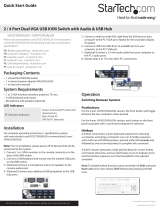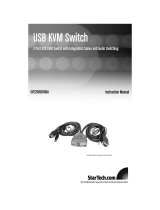
Instruction Manual
4
Installation
Installing the Local Unit
1. Place the Local Unit near the computer.
2. Switch o the computer and disconnect any connected devices.
3. Using the provided StarTech.com integrated KVM cable, connect the end of the
cable that has the USB or PS/2 + VGA connectors to the VGA Out connectors and the
USB or mouse and keyboard PS/2 connectors on the computer as appropriate. (The
PS/2 version of the cable is color-coded.) Connect the opposite end of the cable
with a single connector to the gray-coded connector marked COMPUTER on the
Local Unit of the KVM extender.
4. Use Video cable for the connection between the video port on the computer side of
the Unit and the video output port of the connected Computer.
5. Use Video cable for the connection between the video port on the console side of
the Unit and the video input port of the connected monitor.
6. Use a CAT5 cable for the connection between the respective RJ45 port (Cat5 1 &
Cat5 2) on the Remote and Local Unit.
7. If you wish to have console access to the local computer, connect a USB mouse,
keyboard, and VGA monitors to the indicators marked as CONSOLE on the Local Unit.
8. Connect the UTP cable connections for Remote Unit to the NETWORK RJ-45
connector on the Local Unit. Connect the opposite end to a terminated wall outlet
(if you are using premises cabling).
Installing the Remote Unit
1. Place the Remote Unit near the computer.
2. Switch o the computer and disconnect any existing VGA and input connections.
3. Using a StarTech.com integrated KVM cable, connect the end of the cable that has
the USB or PS/2 + VGA connectors to the VGA Out connectors and the USB or mouse
and keyboard PS/2 connectors on the computer as appropriate. (The PS/2 version
of the cable is color-coded.) Connect the opposite end of the cable with a single
connector to the gray-coded connector marked COMPUTER on the Remote Unit of
the KVM extender.
4. Use Video cable for the connection between the video port on the computer side of
the Unit and the video output port of the connected Computer.
5. Use Video cable for the connection between the video port on the console side of
the Unit and the video input port of the connected monitor.
6. Use a CAT5 cable for the connection between the respective RJ45 port (Cat5 1 &
Cat5 2) on the Remote and Local Unit.

























